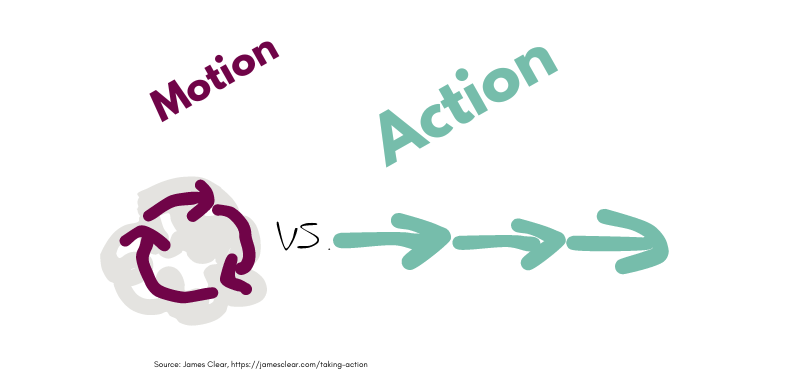There’s a difference between being in motion and taking action. It’s subtle, but matters to the way we spend our time and where we invest our energy. In my personal experience, finding the “right” balance between motion and action impacts my sense of work satisfaction.
Work avoidance in disguise
As I go about my week, I am continuously adding to and revising my work-related to-dos, project ideas, and plans. I chip away at these as I can, catching little bits of time here and there to move things forward.
In the past, I had a daily practice of doing deep work. I would carve out time to do that, treasuring the opportunity to focus. Now, even when I have the time to work on something substantial, I find myself frequently avoiding it or doing something more trivial. My reasons for shirking the significant work often present as “I need to get task X done, it’s time-sensitive” — but, I suspect the real reasons have more to do with perfectionism.
I can see what I’m doing (or, rather, what I’m NOT doing) when I avoid. And keenly aware that I’m missing out on the fulfillment that comes from tackling and making progress on challenging and important work.
Because I yearn to have the fulfillment that comes from tackling the “real work” (vs piddling around), I have been mucho (sic.) excited about the concept represented in the visual below! It describes my recent pattern well: I spend more time in motion than in action. I’m in the motion-vortex.
Motion vs action

Being in motion vs taking action: Examples
Let’s take a look at some examples of motion and action:
- I tweak my slides for a presentation, that’s motion. I create the slides and then rehearse, that’s action. (Admission: I tweaked and re-tweaked the slides for the conference keynote I gave May 28).
- You look through your LinkedIn network for people to contact for informational interviews, that’s motion. You book a meeting and have a career conversation with one of these people, that’s action.
- You say you want to pursue a certificate that will contribute to your work skills and enhance your employability, that’s motion. You register for a class and begin the first module, that’s action.
- You research companies you might like to apply to for work, that’s motion. You submit your resume to a company, that’s action.
Both motion and action are necessary to get things done and make traction on our goals. However, we sometimes kid ourselves that we’re in action, when we’re actually in motion.
Prompts to shift us to “taking action”
It’s not always easy to spot the difference between motion and action, because it can be subtle. However, it IS easy to slip into “being in motion” even when we truly want to be taking action. I speak from experience!
Here are some questions that might help re-direct you to action when you’re gliding in motion:
- What project/task/initiative am I avoiding? What am I worried about?
- If I had confidence about the end result of working on project X/tackling Y, what piece would I address today?
- What is a believable thought I can tell myself about tackling this (apparently) more challenging task?
Credit: I was introduced to the motion-action concept and visual in this blog post by James Clear, author of Atomic Habits.


